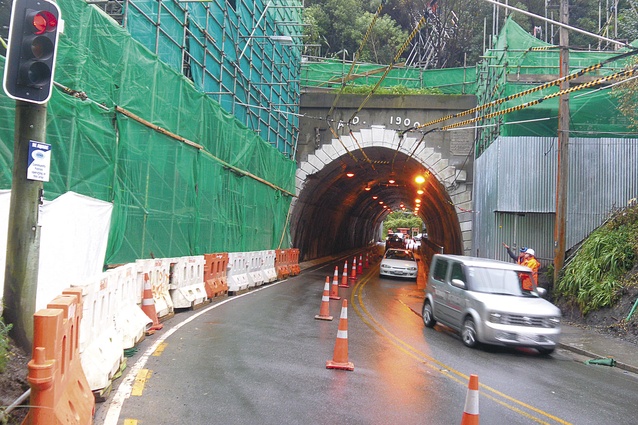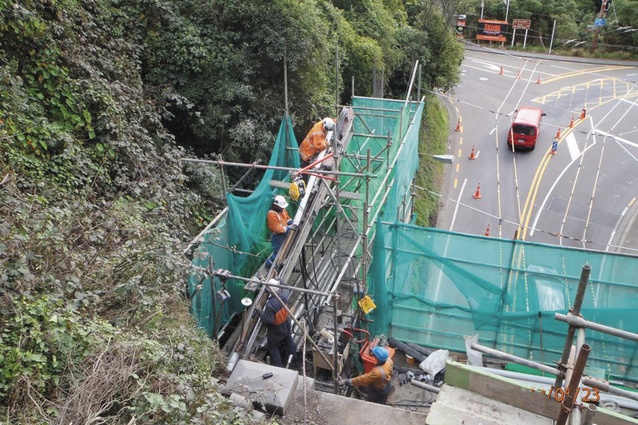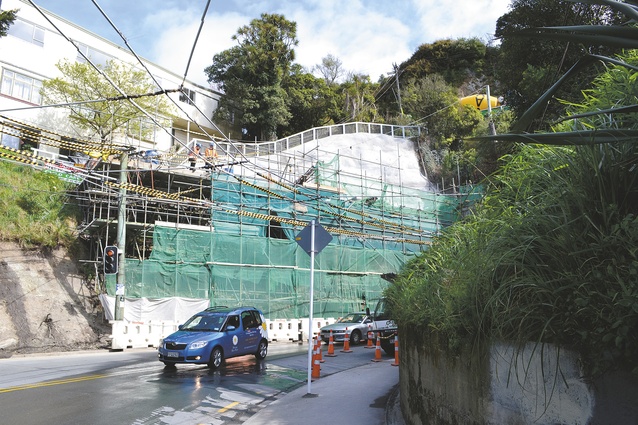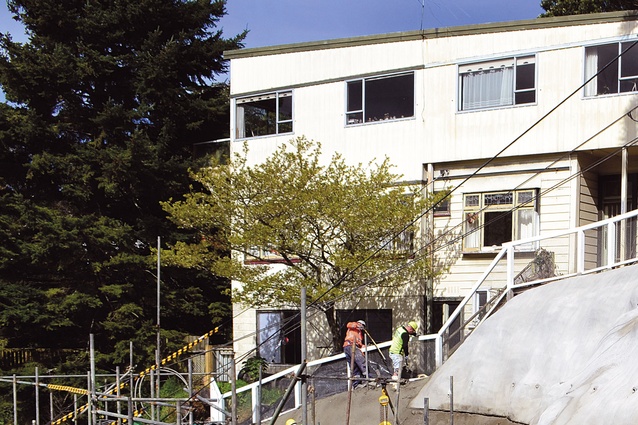Small tunnel, mighty activity
There is a lot going on around Karori Tunnel in Wellington. The tunnel, which links Karori, one of Wellington’s largest suburbs, with Kelburn and the city is being earthquake strengthened.
The portals and southeast bank are heavily scaffolded and covered with green scrim as contractor Fulton Hogan drills, reinforces and retains the fractured greywacke. Traffic queues, managed by lights and staff are part of the activity. Up to 16,000 vehicles per day pass through the tunnel – on average, around 1,000 vehicles per hour during peak times, including 12 buses in each direction. Pedestrian numbers are particularly high in the early morning and late afternoon as residents walk to and from the city.The tunnel is 76 metres long, 7.71 metres wide and 5.8 metres high, and is in close proximity (five to 20 metres) to the Wellington Fault trace on the eastern (Kelburn side) entrance.
“The tunnel portal’s seismic strengthening has been designed to withstand a ground acceleration of 0.53g for which the return period is 1000 years, without sustaining any major damage. For ground shaking with a return period significantly greater than this, the tunnel portals may sustain extensive damage, but they are not expected to collapse,” says Beca engineer, Tim Arianpour.
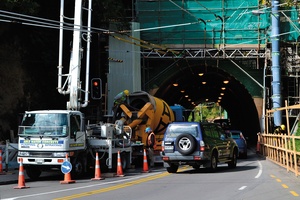
The soil-nail shotcrete wall at the southeast corner of the site is designed for an earthquake with a 500-year return period. An earthquake on the Wellington Fault could result in significantly large displacements. It is not practical, nor feasible to design the shotcrete wall for such large ground displacements, Arianpour says.
“However, it is anticipated that the overall integrity of the soil-nailed block will be largely maintained with localised disruption to the facing and nails within the rupture zone. Additional soil nails and facing repair work will likely be required following such an event.”
The tunnel strengthening comprises three elements – the western portal (Karori side), eastern portal (city side) and the soil-nail wall adjacent to the eastern portal. Work includes rebuilding both portals and securely attaching them to the hillside, constructing a new sprayed-concrete (shotcrete) retaining wall along Glenmore Street on the Kelburn approach to the tunnel, and recreating the tunnel’s historic facade and plaques.
The inside of the tunnel will not be upgraded at this stage; however, engineers for the client, Wellington City Council (WCC) are investigating ways of controlling water seepage.
There are multiple challenges for the engineers and contractor. The location and nature of the site – a busy urban-suburban artery with high traffic volumes – requires that the project minimises impact on the public, and maximises safety. The very low strength and highly fractured greywacke for fixing of rock anchors provides another challenge, as does the design of support to nearby slopes within the fault-shattered greywacke. And heritage design constraints around the portals limit possible strengthening options.
The project required detailed planning and communication with local residents and businesses.
“We have built retaining walls around the city, for example, the Wellington bypass, but nothing like this,” says Darren Oakly, project manager for Fulton Hogan. “It’s one of the trickier ones, with the location of the tunnel, the traffic and the public.”
In the planning stage WCC did extensive work on traffic modelling and management. They installed semi-permanent traffic lights on both sides of the tunnel to synchronise with the rest of the traffic lights in the area. Publicity to Karori businesses and residents recommended the use of detours to reduce the volume of traffic through the tunnel.
“Our customer officer went to every single business and gave them a letter and explained what we would be doing. Fulton Hogan did the same with the residents around the area,” says Faiz Tawfeek, WCC team leader – Roading, Operations and Infrastructure.
Structural scaffolding is anchored to the banks and has been especially designed by the engineers to take loads including the 1.5 tonne drills.
“Normally the rigs we use to drill would be mounted on a 25 tonne digger,”
Oakly says. “This minimises disruption to the traffic. We’ve taken off the digger and just mounted it to the scaffolding. The structure is designed to stand alone, and it’s working well,”
In such a high-risk area scrim and kickboards ensure that any falling debris is contained out of the way of workers and the public.
To construct the retaining shotcrete wall the contractor drilled 160 12-metre soil nails, at a spacing of 1.5 metres. To stop the bank from frittering, a 50 mm layer of concrete was sprayed like a screed, says Oakly. Concrete was then sprayed over the top and the nail heads thickened with another 200 mm of concrete.
To enable work on the buttresses, steel plates provide temporary support and permanent rock anchors hold the portals until pre-cast concrete units can be put in place. Then the rest is boxed with reinforcement and 400 mm thick concrete is laid. There are 35 large, double corrosion protection rock anchors through the existing buttresses – 14 on the western side and 21 on the east, and they drill a 200 mm diameter hole.
“We drill down through that and get into some hard rock below the tunnel invert, and then the anchor gets grouted with cement to the rock.”
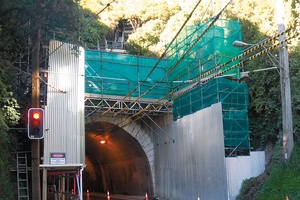
The anchors are high tensile bars, 40 mm in diameter, and between 12 and 25 metres long, with the bonded length between nine and 10 metres into the hillside. Permanent steel casing with a corrugated high density polythene sheath goes through the overburden behind the existing portal walls to the rock face. The rock anchors pin the portals on a diagonal and are anchored deep into the bedrock.
“It’s typical Wellington rock, highly fractured greywacke,” Oakly says. “We’ve hit veins where it has been crushed by seismic activity. The whole purpose of the strengthening is to keep access to the public after a seismic event and to avoid casualties. Investigations have shown the barrel of the tunnel is not expected to collapse in an earthquake. The portals and the banks are the issue – they might collapse and close the tunnel.”
The rounded shape of tunnels has good load bearing capacity and the tunnel barrel is solidly built with seven courses of bricks. There are new, fully reinforced capping beams above the portal face and buttresses.
Karori Tunnel, Wellington’s oldest road tunnel was designed by civil engineer James Edward Fulton and completed in 1900. The date appears above the apex of the tunnel. The tunnel is now listed as Category II on the register of the Historic Places Trust, and is subject to monitoring throughout the project.
The portals, as the face of the tunnel, speak of the growth and aspirations of the city, in particular the suburb of Karori, and have significant heritage values.
The project began in February 2012 and is expected to be finished towards the end of the year.


